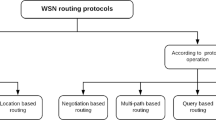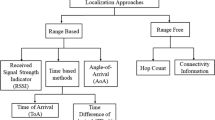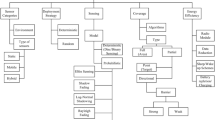Abstract
Energy is the determinant factor for the survival of Mobile Sensor Networks (MSN). Based on the analysis of the energy distribution in this paper, a two-phase relocation algorithm is proposed based on the balance between the energy provision and energy consumption distribution. Our main objectives are to maximize the coverage percentage and to minimize the total distance of node movements. This algorithm is designed to meet the requirement of non-uniform distribution network applications, to extend the lifetime of MSN and to simplify the design of the routing protocol. In addition, test results show the feasibility of our proposed relocation algorithm.
Similar content being viewed by others
References
Yi Zou and Krishnendu Chakrabarty. Sensor deployment and target localization based on virtual forces. IEEE INFOCOM, San Francisco, CA, US, 2003, Vol.2, 1293–1303.
Guiling Wang, Guohong Cao, and Tom la Porta. movement-assisted sensor deployment. IEEE INFOCOM, Hong Kong, 2004, Vol.4, 2469–2479.
Jie Wu and Shuhui Yang. SMART: A Scan-based movement-assisted sensor deployment method in wireless sensor networks. IEEE INFOCOM, Miami, FL, US, 2005, Vol.4, 2313–2324.
Sriram Chelappan, Xiaole Bai, Bin Ma, and Dong Xuan. Sensor networks deployment using flip-based sensors. IEEE International Conference on MASS’ 2005, Washington DC, US, 2005, 298–305.
Guiling Wang, Guohong Cao, Tom la Porta, and Wensheng Zhang. Sensor relocation in mobile sensor networks. IEEE INFOCOM, Miami, FL, US, 2005, Vol.4, 2302–2312.
Santosh Kumar, Ten H. Lai, and Jozsef Balogh. On k-coverage in a mostly sleeping sensor network. ACM, Mobicom’04, Philadelphia, PA, US, 2004, 144–158.
Li Li, Joseph Y. Halpern, Paramvir Bahl, Yi-Min Wang, and Roger Wattenhofer. Analysis of a cone-based distributed topology control algorithm for wireless multi-hop networks. In Proceedings of ACM Principles of Distributed Company (PODC), Newport, RI, US, 2001, 264–274.
Sriram Chellappan, Xiaole Bai, Bin Ma, Dong Xuan, and Changqing Xu. Mobility limited flip-based sensor networks deployment. IEEE Transactions on Parallel Distributed Systems, 18(2007)2, 199–211.
Yi Zou and Krishnendu Chakrabarty. A distributed coverage- and connectivity-centric technique for selecting active nodes in wireless sensor networks. IEEE Transactions on Computers, 54(2005)8, 978–991.
Xiaorui Wang, Guoliang Xing, Yuanfang Zhang, Chenyang Lu, Robert Pless, and Christopher Gill. Integrated coverage and connectivity configuration in wireless sensor networks. The First ACM Conference on Embedded Networked Sensor Systems, Los Angles, CA, US, November 2003, 28–39.
Ning Li, Jennifer C. Hou, and Lui Sha. Design and analysis of an MST-based topology control algorithm. IEEE Transactions on Wireless Communications, 4(2005)3, 1195–1206.
Andrew Howard, Maja J. Mataric, and Gaurav S. Sukhatme. Mobile sensor network deployment using potential fields: A distributed, scalable solution to the area coverage problem. In Proceedings of the 6th International Symposium on Distributed Autonomous Robotics Systems (DARS’ 02), Fukuoka, Japan, 2002, 299–308.
Author information
Authors and Affiliations
Corresponding author
Additional information
Communication author: Pei Zhiqiang, born in 1979, male, Master.
About this article
Cite this article
Pei, Z., Xu, C. & Teng, J. Relocation algorithm for non-uniform distribution in Mobile Sensor Network. J. Electron.(China) 26, 222–228 (2009). https://doi.org/10.1007/s11767-007-0130-0
Received:
Revised:
Published:
Issue Date:
DOI: https://doi.org/10.1007/s11767-007-0130-0




